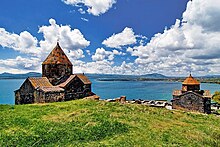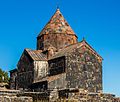| Sevanavank | |
|---|---|
| Սևանավանք | |
 The churches of Surp Arakelots (left) and Surp Astvatsatsin (right) The churches of Surp Arakelots (left) and Surp Astvatsatsin (right) | |
| Religion | |
| Affiliation | Armenian Apostolic Church |
| Status | Active |
| Location | |
| Location | Sevan Peninsula, Lake Sevan, Armenia |
  | |
| Geographic coordinates | 40°33′50″N 45°00′39″E / 40.563917°N 45.010808°E / 40.563917; 45.010808 |
| Architecture | |
| Style | Armenian |
| Completed | 9th century |
Sevanavank (Armenian: Սևանավանք; meaning Sevan Monastery) is a monastic complex located on a peninsula at the northwestern shore of Lake Sevan in the Gegharkunik Province of Armenia, not far from the town of Sevan. Initially the monastery was built at the southern shore of a small island. After the artificial draining of Lake Sevan, which started in the era of Joseph Stalin, the water level fell about 20 metres, and the island transformed into a peninsula. At the southern shore of this newly created peninsula, a guesthouse of the Armenian Writers' Union was built. The eastern shore is occupied by the Armenian president's summer residence, while the monastery's still active seminary moved to newly constructed buildings at the northern shore of the peninsula.
Due to easier accessibility (once it became a peninsula), good highway and railway connections with the Armenian capital Yerevan, a well-developed tourist industry in the nearby town of Sevan, and its picturesque location (although less picturesque than it was before the lake level drop), Sevanavank is one of the most visited tourism sights in Armenia.
History
According to an inscription in one of the churches, the monastery of Sevanavank was founded in 874 by Princess Mariam, the daughter of Ashot I (who became a king a decade later). At the time, Armenia was still struggling to free itself from Arab rule.
The monastery was strict as it was mainly intended for those monks from Etchmiadzin who had sinned. Jean-Marie Chopin, a French explorer of the Caucasus, visited there in 1830 and wrote of a regimen restraining from meat, wine, youth or women. Another explorer visited the monastery in 1850 and wrote of how manuscripts were still being copied manually.
Architecture
The two churches of the complex, Surp Arakelots meaning the "Holy Apostles" and Surp Astvatsatsin meaning the "Holy Mother of God", are both cruciform plan structures with octagonal tambours. The two are quite similar to each other in appearance. Adjacent are the ruins of a gavit whose roof was originally supported by six wooden columns. Some of the remains of the gavit and its columns can be seen in the Yerevan Museum of History.
Reconstruction and restoration efforts took place from 1956 to 1957.
Gallery
-
 The island and the Sevan Monastery during the 19th century (Paris, 1869, T. Deyrolle)
The island and the Sevan Monastery during the 19th century (Paris, 1869, T. Deyrolle)
-
 Sevanavank and peninsula along Lake Sevan
Sevanavank and peninsula along Lake Sevan
-
Sevanavank monastery viewed from the lake
-
 View of the peninsula
View of the peninsula
-
 Surp Arakelots church
Surp Arakelots church
-
 Surp Arakelots church
Surp Arakelots church
-
 Carved walnut wood door (1486) from the Church of the Holy Apostles, Lake Sevan.
Carved walnut wood door (1486) from the Church of the Holy Apostles, Lake Sevan.
-
 Surp Astvatsatsin church
Surp Astvatsatsin church
-
 Altar of Surp Arakelots
Altar of Surp Arakelots
-
Khachkars along the ruins of the gavit
-
 Church of Surb Arakelots and Church Astvatsatsin
Church of Surb Arakelots and Church Astvatsatsin
 Panoramic view of the Sevan Peninsula
Panoramic view of the Sevan Peninsula
References
- Sergio La Porta. Monasticism and the construction of the Armenian intellectual tradition // Monasticism in Eastern Europe and the Former Soviet Republics / Edited by Ines Angeli Murzaku. — Routledge, 2015. — P. 332 "One of the earliest instances of a princely foundation for a monastic complex was the monastery of Sewan. Its foundation also provides the earliest explicit reference to the use of the Basilian Rule, translated in the sixth century, by an Armenian monasctic community (Garsoian 2005—7: 183). The monastery was built in 874 on the island of Sewan in Lake Sewan by Princess Mariam, daughter of Prince of Princes Ašot Bagratuni and widow of Prince Vasak Gabur Siwni (Pogossian 2012). Mariam's example was followed by her son Grigor Sup'an II as well as by other members of the Bagratuni royal family and princess of Siwnik'."
- Armenia: Art, Religion, and Trade in the Middle Ages - MetPublications - The Metropolitan Museum of Art. Metropolitan Museum of Art. 2018. pp. 186–187.
Cat.79 Carved Door Church of the Holy Apostles (Surb Arak'elots'), Monastery of Sevan (Sevanavank'), Lake Sevan, 1486, Walnut, History Museum of Armenia, Yerevan (86)
Bibliography
- Kiesling, Brady (2005), Rediscovering Armenia: Guide, Yerevan, Armenia: Matit Graphic Design Studio
External links
- About Sevanavank
- Armenian Architectural Studies: Sevanavank
- Armeniapedia.org: Sevanavank
- Sevan Pictures at Armenia Photos.info
- Armenica.org: Sevanavank
- Details About Sevanavank Monastery
- A Visit To Sevanavank Monastery



